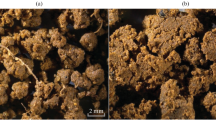Summary
14C-labelled substrates were incubated at 20°C in 4 soils with clay contents ranging from 6 to 34%. Glucose was most readily decomposed, followed in order by hemicellulose, cellulose, maize straw, and barley straw. After the first 10 days of incubation, about 60% of the glucose-C had left the soils as CO2, compared with only 23% of the barley-C.
The humified matter that remained in the soils after 3 months decayed at almost the same rate whether the origin of the matter was glucose, hemicellulose, cellulose or straw; this rate was, on the whole, independent of the caly content of the soils. Half-life values for the labelled C in the soils during the second and third year of incubation ranged from 5 to 7 years. The amino acid-C percentages of the humified matter tended in all four soils to be largest in matter originating from glucose and least in that originating from straw. The amino acid-C percentages increased with the clay content of the soils.
The biomass was determined by fumigation with CHCl3 according to Jenkinson. After 3 months an average of 17% of the residual labelled C was in biomass; the values ranged from 37% when the labelled C was added as glucose to 2–9% when added as barley straw. The half-life of labelled C in biomass during the second year of incubation ranged from 2 to 3 years.
Native C in biomass ranged from 0.5 to 1.4% of the total C in native soil organic matter, the highest values occurring in the clay-rich soils. The half-life of native soil C, estimated from CO2 evolution during 3-month periods, ranged from 13 to 29 years.
Similar content being viewed by others
References
Cerri C C and Jenkinson D S 1981 Formation of microbial biomass during the decomposition of14C-labelled ryegrass in soil. Soil Sci. 32, 619–626.
Haider K, Martin J P and Filip Z 1975. Humus biochemistry.In Soil Biochemistry Vol. 4. Eds. E A Paul and A Douglas McLaren. Marchel Dekker Inc., New York pp 195–244.
Jenkinson D S and Ladd J N 1981 Microbial biomass in soil: measurement and turnover.In Soil Biochemistry Vol. 5 Eds. E A Paul and J N Ladd. Marchel Dekker Inc., New York pp 415–471.
Jenkinson D S and Powlson D S 1976 The effects of biocidal treatments on metabolism in soil-V. A. method for measuring soil biomass. Soil Biol. Biochem. 8, 209–213.
Paul E A and Veen J A van 1978 The use of tracers to determine the dynamic nature of organic matter.In 11th International Congress of Soil Science Vol. 3 Alberta, Canada pp. 61–102.
Sørensen H 1963 Studies on the decomposition of C14-labelled barley straw in soil. Soil Sci. 95, 45–51.
Sørensen L H 1967 Duration of amino acid metabolites formed in soils during decomposition of carbohydrates. Soil Sci. 104, 234–241.
Sørensen L H 1974 Rate of decomposition of organic matter in soil as influenced by repeated air drying-rewetting and repeated addition of organic matterial Soil Biol. Biochem. 6, 287–292.
Sørensen L H 1975 The influence of clay on the rate of decay of amino acid metabolites synthesized in soils during decomposition of cellulose. Soil Biol. Biochem. 7, 171–177.
Sørensen L H 1981 Carbon-nitrogen relationships during the humification of cellulose in soils containing different amounts of clay. Soil Biol. Biochem. 13, 313–321.
Sørensen L H 1983 The influence of stress treatments on the microbial biomass and the rate of decomposition of humified matter in soils containing different amounts of clay. Plant and Soil 75, 107–119.
Stout J D, Goh K M and Rafter T A 1981 Chemistry and turnover of naturally occurring resistant organic compounds in soil.In Soil Biochemistry Vol. 5 Eds. E A Paul and J N Ladd. Marcel Dekker Inc., New York. pp 1–73.
Author information
Authors and Affiliations
Rights and permissions
About this article
Cite this article
Sørensen, L.H. Size and persistence of the microbial biomass formed during the humification of glucose, hemicellulose, cellulose, and straw in soils containing different amounts of clay. Plant Soil 75, 121–130 (1983). https://doi.org/10.1007/BF02178619
Received:
Revised:
Issue Date:
DOI: https://doi.org/10.1007/BF02178619




